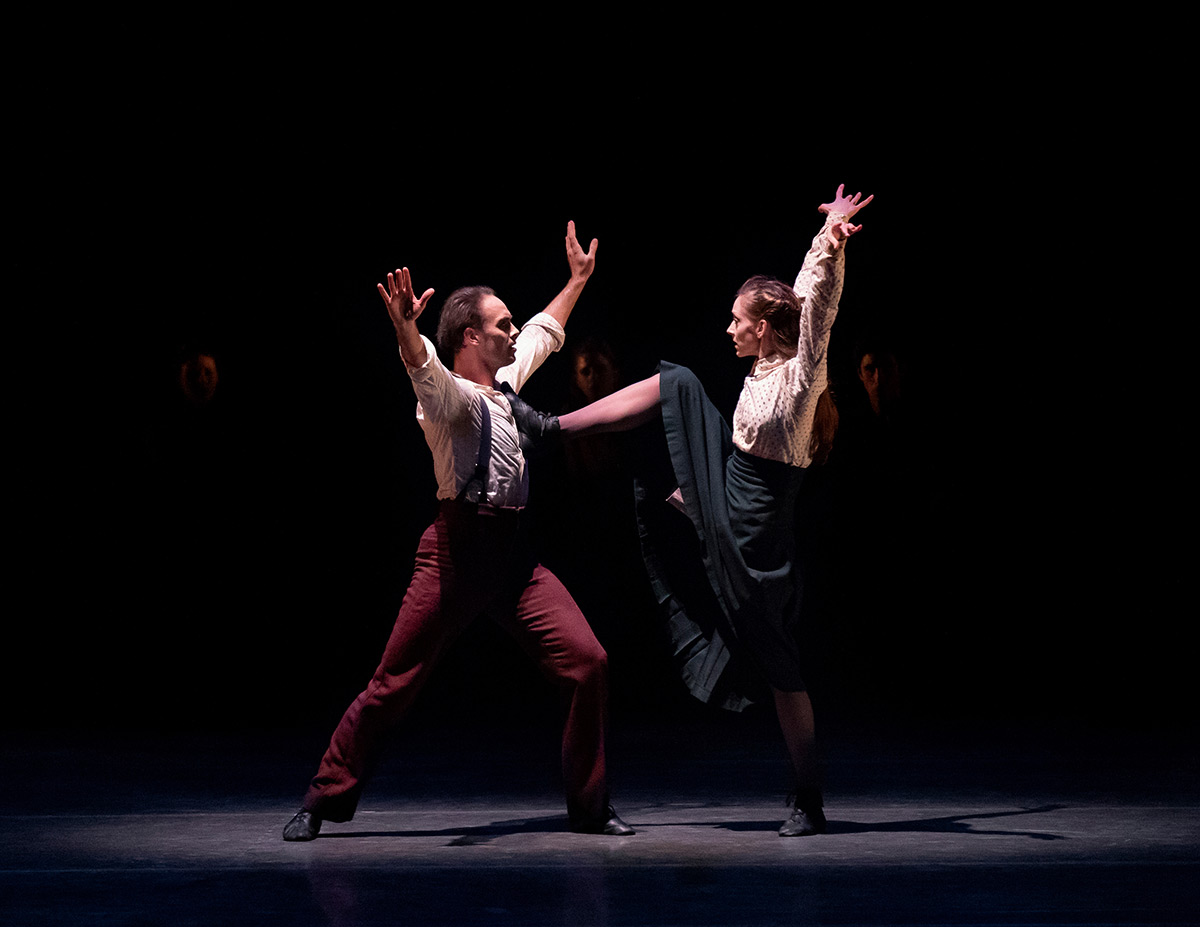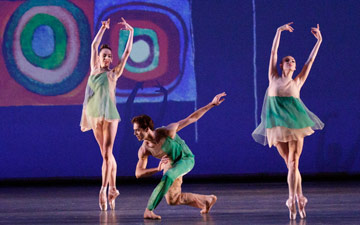
© Paul Kolnik. (Click image for larger version)
New York City Ballet
21st Century Choreographers I: Pictures at an Exhibition, Oltremare, Rodeo: Four Dance Episodes
★★★★✰
New York, David H. Koch Theater
23 April 2019
www.nycballet.com
davidhkochtheater.com
Spring Awakening
A new season begins at New York City Ballet, which finally has new leadership in place after a turbulent year in which it lost its director and several dancers to accusations of misconduct. In February, it was announced that Wendy Whelan would become the company’s Associate Artistic Director, alongside Jonathan Stafford, who has been more or less running things for the past year as part of an interim team. The choreographer in residence, Justin Peck, will now become Artistic Advisor.
Last week, it was reported that one of the fired dancers, Amar Ramasar, will be returning to the company after an arbitrator found that the punishment for his actions – the sharing of lewd photographs via text – had been too harsh. “Suspension was the appropriate punishment,” read the announcement; “termination was too severe.” Another dancer affected by the judgment has chosen not to return. The process of healing the company’s wounds continues.
The dancers have proven remarkably resilient under the circumstances. And it must be said that the interim team has done an excellent job of opening up casting, resulting in some exciting débuts. There is a palpable sense of hope among the dancers; again and again, they rise to the occasion.

© Paul Kolnik. (Click image for larger version)
The opening-night program reflected this resilience and gave reason for hope. The ballets all date from the last decade-or-so; the oldest was Mauro Bigonzetti’s Oltremare, from 2008. The other two, Alexei Ratmansky’s Pictures at an Exhibition and Justin Peck’s Rodeo: Four Dance Episodes, were made in the last five years (Pictures is from 2014, Rodeo from 2015). All three included débuts, some of them accidental – both Tiler Peck and Abi Stafford were injured. All were incisively and convincingly danced, even if Rodeo looked like it could have used a few more rehearsals.
Both Pictures and Rodeo are very, very good ballets – original, engrossing, with a sense of sweep and humanity. Pictures, especially, is characterized by a richness of imagination that keeps you constantly alert, by turns delighted, touched, curious. At each moment, the choreography reveals details in the music with amazing clarity, while at the same time creating its own independent world, mysterious, eccentric, sometimes funny, sometimes haunting. Rodeo combines Peck’s eye for groupings and formations with a deft deployment of humor. With its cast of fifteen men (and one woman), it is both masculine and tender. The third ballet, Oltremare, is much less effective, despite the fact that its theme – the anguish of emigration – is if anything more pressing now than it was at the time of its creation. And yet, it remains consistently plodding, particularly in its relationship with the banal score by Bruno Moretti, composed in a poor-man’s Nino Rota style. The score wasn’t helped at all by some glaring wrong notes in the brass section. The cast of fourteen, dressed in costumes that evoke Ellis Island circa 1900, suffer, embrace, cry; but they suffer in terribly similar ways, the women thrown like rag dolls or flipped over by their feet like pancakes on a griddle.
In Pictures, Indiana Woodward stepped in for an injured Tiler Peck. Though she doesn’t have Peck’s speed or pin-prick accuracy, she held her own and danced with joy and verve. Daniel Ulbricht, débuting in a dramatic passage created for Amar Ramasar to the “Baba Yaga” section in the score – Baba Yaga is a witch out of Russian folklore – lacked Ramasar’s fervor and attack. The role may not be the best fit for this fundamentally sunny dancer. Lauren King slipped seamlessly into the buoyant role originally created for Abi Stafford.

© Paul Kolnik. (Click image for larger version)
At this performance I was struck in particular by a section toward the end, “Catacombs,” in which the dancers enter separately, drifting into relationships with this or that other dancer. Often, the characters move with their backs to the audience, or cover their faces, as if protecting themselves from some danger. A tender, haunting relationship forms between two men, Tyler Angle and Joseph Gordon; one shadows the other, or draws the other forward, pulling him by the hand. Are they brothers, friends, lovers? Who knows. Later, they are pulled apart by a group of men, like spirits or ghosts. The image stays with you.
Rodeo also touches on the relationships between men, young men in particular. They jostle and compete, running across the stage to Aaron Copland’s fantastically energetic score. But they also comfort each other and experience moments of vulnerability and doubt. I love the moment in which each of the three “teams” – dressed in sporty rugby attire – toss one man into the air, much as rugby players do at the start of a “lineout”, when the ball goes into play. In contrast, during the aching “Corral Nocturne,” the men form long chains, with one reaching away from the others, expressing doubt or longing. Jonathan Fahouri, a corps dancer, was touchingly vulnerable in the role of the outsider.

© Paul Kolnik. (Click image for larger version)
Peck has woven in striking images, like a repeating sunburst of legs, reminiscent of Apollo. The ballet’s one weakness is the pas de deux for one of the men (the elegant Russell Janzen, débuting) and a female interloper (Sara Mearns). Not only is it not quite clear what the woman’s function is supposed to be, but the duet has a catch-and-release dynamic that kills its momentum. Sara Mearns’s prodigious energy seems wasted here. Still, the ballet is a joy, even if the performance could have used some fine-tuning to give it a more unified look. The orchestra, too, sounded rather rough.
But then, a little roughness is not unusual at the start of the season. A program like this one makes one eager for more.

















You must be logged in to post a comment.